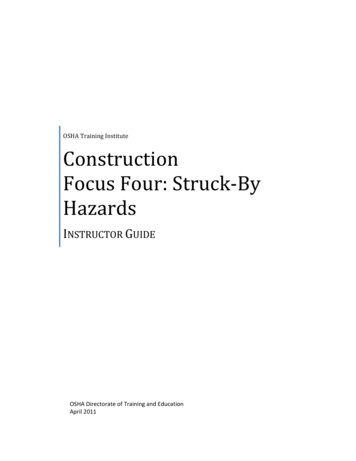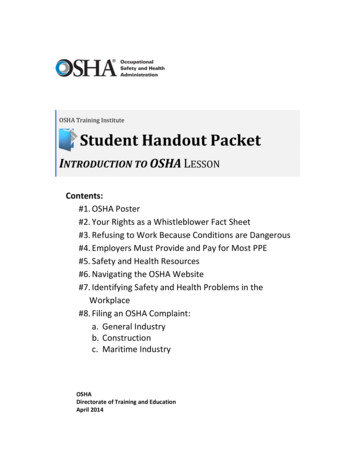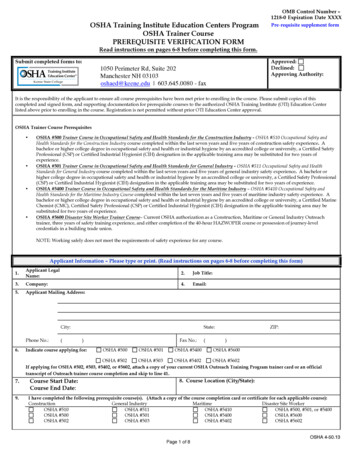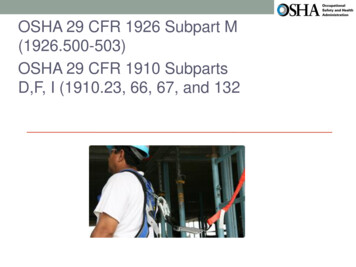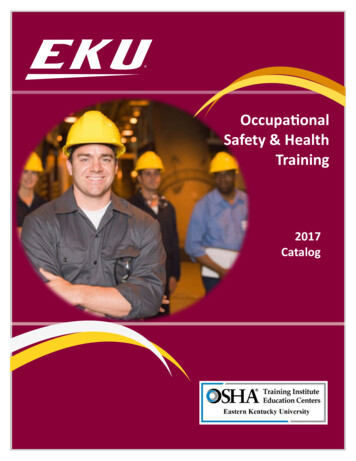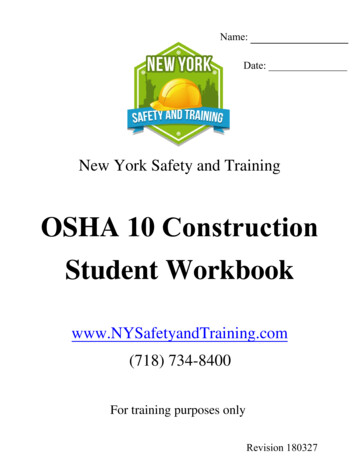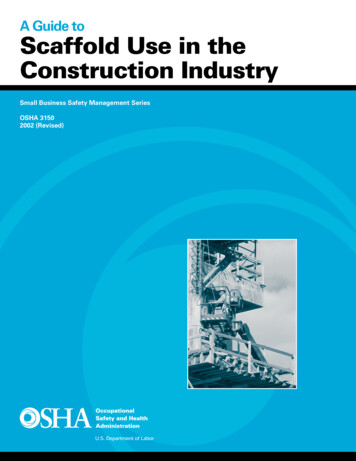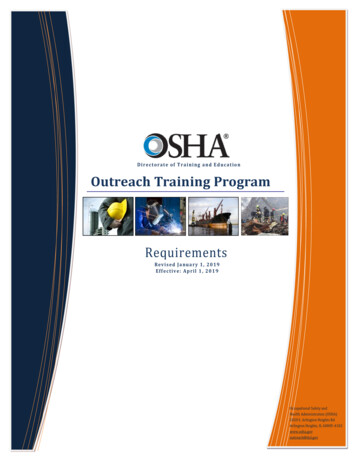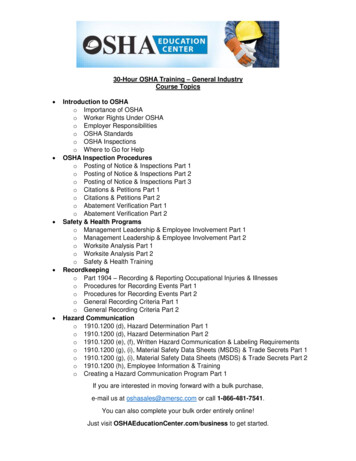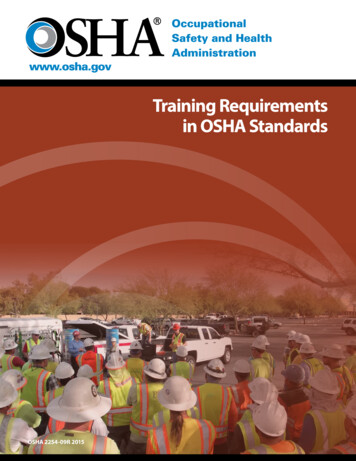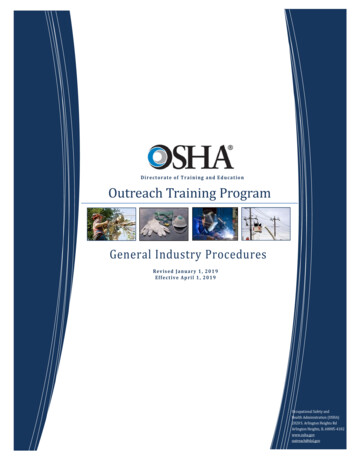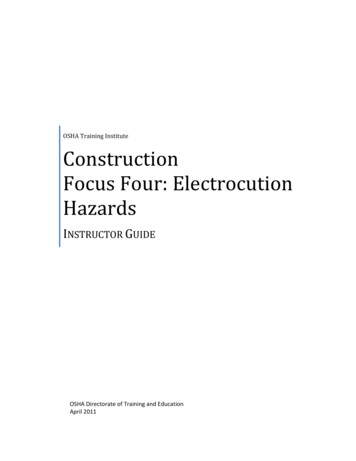
Transcription
OSHA Training InstituteConstructionFocus Four: ElectrocutionHazardsINSTRUCTOR GUIDEOSHA Directorate of Training and EducationApril 2011
Construction Focus Four: Electrocution HazardsTable of ContentsTRAINER PREPARATION GUIDANCE . iOnline Resources . iiOverview .1Topic 1: What is an electrocution hazard?.2A. Definition.2B. Examples .4C. Statistics .5Topic 2. What are the major types of electrocution hazards in construction?.6A. Contact with power lines.6B. Contact with energized sources.8C. Improper use of extension and flexible cords .10Topic 3. How can I protect myself from electrocution hazards? .13A. Maintain safe distance from overhead power lines.13B. Use ground-fault circuit interrupters (GFCI).15C. Inspect portable tools and extension cords .17D. Use power tools and equipment as designed.18E. Follow lockout/tagout procedures .19Topic 4. What is my employer required to do to protect workers from electrocutions?.21A. Ensure overhead power line safety .21B. Isolate electrical parts .22C. Supply GFCI .22D. Establish and implement an AEGCP .23E. Ensure power tools are maintained in safe condition .24F. Ensure proper guarding .24G. Provide training .24H. Enforce LOTO safety-related work practices.25I. Ensure proper use of flexible cords.25Summary.26References/Sources .27APPENDIXAppendix A: Electrocution Hazards Lesson Test. A1Appendix B: Activity Options A and B . B1Appendix C: Fatal Facts. C1Appendix D: Student Handouts. D104/2011
Construction Focus Four: Electrocution Hazards04/2011
Construction Focus Four: Electrocution HazardsTRAINER PREPARATION GUIDANCEThe “Construction Focus Four: Electrocution Hazards” lesson is part of the 4-hour block consisting ofsegments on each of the Focus Four Hazards: Falls, Caught-In or -Between, Struck-By and Electrocution.Because most construction fatalities are caused by fall hazards, falls must be covered for at least onehour, and we recommend at least one hour and 15 minutes. The other focus four hazards lessons, suchas this one, must be covered for a minimum of one-half hour each. This training is developed to be usedin both the 10- and 30-hour OSHA Outreach Training programs and if applicable, for other safety andhealth training purposes.Using the Instructor Guide (IG): The IG consists of instructions for trainer preparation, resources, alesson plan, references, and Appendices. The IG contains content, activities and notes for the instructor.It is not intended to be a script that is read verbatim to the students. Rather, instructors shouldreview the entire guide (including referenced materials and internet links) prior to conductingtraining, and use it as a resource in their planning and presentation.The learning objectives and testing: The “Construction Focus Four: Electrocution Hazards” lessonsegment was developed based on the terminal (TO) and enabling objectives (EO) below. Theseobjectives are the expected student outcomes; therefore, 1) the instructor may not vary from theseobjectives when planning the training session; and 2) the objectives must be measured by testing thestudent’s achievement. A test is provided in Appendix A; however, the trainer may develop a modified setof test questions to meet the needs of the audience as well as to measure the student’s achievement ofthe stated objectives.TO: Given current OSHA and industry information regarding construction worksite illnesses, injuriesand/or fatalities, the student will be able to recognize electrocution hazards in construction.Specifically, the student will be able to:EO 1: Identify major electrocution hazardsEO 2: Describe types of electrocution hazardsEO 3: Protect him/herself from electrocution hazardsEO 4: Recognize employer requirements to protect workers from electrocution hazardsUsing the Slide Presentation: The Microsoft PowerPoint 2003 presentation file consists of electrocutionhazard recognition photos which the trainer may use as an activity during the session. The presentationformat is one slide asking if students recognize any hazards followed by a slide displaying the samephoto containing the answer. The instructor may add additional slides to the presentation based on thelesson content or use their own slides, if appropriate to the lesson content.Appendices: Provided in the Appendices are the instructor and student copies of the lesson test, lessonactivity documents along with student handouts. Refer to the Table of Contents for details.Media and/or Teaching Methods: This lesson is one of four segments covering the construction focusfour hazards. It has been set up as a facilitated, interactive training session. Students are given small“chunks” of information, and then are able to practice their understanding of the subject matter viaactivities and workshops. There is a lesson test provided for each focus four segment.Ideal Setting or Conditions for the Training Session: The ideal setting is a classroom or other areawhere students have space to break into groups.Disclaimer: This Compliance Assistance product is not a standard or regulation, and it creates no newlegal obligations. The Compliance Assistance product is advisory in nature, informational in content, and isintended to assist employers in providing a safe and healthful workplace. Pursuant to the OccupationalSafety and Health Act, employers must comply with safety and health standards promulgated by OSHA orby a State with an OSHA-approved State Plan. In addition, pursuant to Section 5(a)(1), the General DutyClause of the Act, employers must provide their employees with a workplace free from recognized hazardslikely to cause death or serious physical harm. Employers can be cited for violating the General DutyClause if there is a recognized hazard and they do not take reasonable steps to prevent or to abate thehazard. However, failure to implement these recommendations is not, in itself, a violation of the GeneralDuty Clause. Citations can only be based on standards, regulations, and the General Duty Clause.04/2011Page i
Construction Focus Four: Electrocution HazardsOnline ResourcesCalifornia Department of Public ges/Publications.aspxConstruction Chart Book, Fourth uction-chart-book-4th-edition.htmlConstruction nsafety/Controlling Electrical Hazards: rical Safety: cal Safety /electrical incidents/mainpage.htmlElectrical Safety and Health Topics: trical Safety Tips OSHA quick Card:http://www.osha.gov/OshDoc/data Hurricane Facts/electrical safety.pdfElectrical Safety: Safety and Health for Electrical Trades Student ult.htmlElectrocutions During Work with Scaffolds Near Overhead Power Lines:http://www.cdc.gov/niosh/91-110.htmlFatality Assessment and Control Evaluation (FACE) Program:http://www.cdc.gov/niosh/face/NFPA 70E: Standard for Electrical Safety in the Workplace p?DocNum 70ENIOSH Electrical Safety Manual: http://www.cdc.gov/niosh/docs/2009-113/NIOSH Face Reports: le Generator Safety Tips OSHA Quick Card:http://www.osha.gov/OshDoc/data Hurricane Facts/portable generators.pdfPreventing Fatalities of Workers Who Contact Electrical Energy: http://www.cdc.gov/niosh/87-103.htmlPreventing Electrocutions Due to Damaged Receptacles and Connectors: http://www.cdc.gov/niosh/87100.htmlUsing Portable Generators Safely. OSHA Fact Sheet:http://www.osha.gov/OshDoc/data Hurricane Facts/portable generator safety.pdfWorking Safely with Electricity. OSHA Fact Sheet:http://www.osha.gov/OshDoc/data Hurricane Facts/elect safety.pdf04/2011Page ii
Construction Focus Four: Electrocution HazardsOverviewThe purpose of this lesson is to provide workers with information that willenable them to recognize major electrocution hazards at constructionworksites. This Instructor Guide (IG) is intended to be used when presentingthe OSHA Training Institute Construction Outreach 10- and/or 30- hour course.The lesson is comprised of the following four topics:1.2.3.4.What is an electrocution hazard?What are the major types of electrocution hazards in construction?How can I protect myself from electrocution hazards?What is my employer required to do to protect workers fromelectrocution?Materials Needed:Flip chart and markersPresentation slidesStudent handoutsStudent copies ofplanned activities Copy of the OSHAConstruction Standards Questions for Review &Answers If activity files are usedfor hazard recognition,copyPPTinstrHazRecAlt Electr April2011.pdf andPPTstudentHazRecAlt Electr April2011.pdf 04/2011TrainingPreparation: HelpfulReferences/OnlineResources listed in thisdocument OSHA ConstructionStandards Appendix A: TestQuestions [instructorand student copies] Appendix B: ActivityOptions A and B[instructor and studentcopies] Appendix C: FatalFacts Worksheets[instructor and studentcopies] Appendix D: StudentHandoutsStudentHandouts: “Construction FocusFour: Electrocution,Safety Tips forWorkers” tri-foldbrochure formatFocus Four ToolboxTalks 1, 2, and 3produced by IUOENational TrainingFund under OSHAgrant number SH16591-07-06-F-11OSHA Quick CardTM“Electrical Safety”Page 1
Construction Focus Four: Electrocution HazardsInstruction for this session:1. Ask the class if they can give an example of anelectrical hazard on a construction site thatcould cause a worker to be electrocuted.Discuss the examples with the class. Be surethat examples of the most common electricalhazards are covered such as, contact withpower lines, faulty extension cords, impropergrounding of equipment, etc.2. Discuss the content.3. Show photos of electrocution hazards and havethe class identify the hazards shown.4. If time permits, conduct one of the followingsmall group activities: Option A: Wet Conditions / Ground FaultCircuit Interrupters Option B: Extension Cords, Copper andCurrent5. Conduct the lesson test and discuss answerswith the studentsNOTES:Refer to “Condensed ElectricalGlossary” section of theConstruction Focus Four:Electrocution tri-fold handout[Appendix D]Preview photos in “HazardRecognition” PowerPointpresentation. As an alternative,trainers can use their own photosin the hazard recognitionpresentation. If the presentation isused as provided, the trainer canuse the activity files provided toadd interactivity by having thestudents involved in note taking.To conduct the activity, locate andprint the PDF files titled:PPTinstrHazRecAlt Electr April2011.pdf andPPTstudentHazRecAlt Electr April2011.pdfOption A and Option B scenariosand student worksheets are foundin Appendix BLocate instructor and studentcopies of test in Appendix A.Topic 1: What is an electrocution hazard?A. DefinitionB. ExamplesC. StatisticsContent for Topic 1:A. DefinitionElectrocution results when a person is exposed to alethal amount of electrical energy.Preview photos in “HazardRecognition” PowerPointpresentation.An electrical hazard can be defined as a seriousworkplace hazard that exposes workers to thefollowing: Burns Electrocution Shock Arc Flash/Arc Blast Fire Explosions04/2011Page 2
Construction Focus Four: Electrocution HazardsTherefore, BE SAFE by recognizing, avoiding andprotecting against all of these electrical hazards.These BE SAFE terms are defined as:B Burns:A burn is the most common shock-related injury.Burns from electricity are one of three types:Electrical, Arc/Flash or Thermal Contact.E Electrocution:Electrocution is fatal; it means to kill with electricity.Electrocution results when a human is exposed to alethal amount of electrical energy.NOTES:The types of burns from electricityare further defined as: Electrical burns result from heatgenerated by the flow of electriccurrent through the body Arc/Flash burns are hightemperature burns caused byan electric arc or explosion Thermal contact burns occurwhen skin comes in contact withoverheated electric equipmentS Shock:Shock results when the body becomes part of theelectrical circuit; current enters the body at one pointand leaves at another. Electrical shock is defined as areflex response to the passage of electric currentthrough the body.A Arc Flash/Blast:An arc flash is the sudden release of electrical energythrough the air when a high-voltage gap exists andthere is a breakdown between conductors. An arcflash gives off thermal radiation (heat) and bright,intense light that can cause burns. Temperatures havebeen recorded as high as 35,000 F. High-voltagearcs can also produce considerable pressure wavesby rapidly heating the air and creating a blast.F Fire:Most electrical distribution fires result from problemswith "fixed wiring" such as faulty electrical outlets andold wiring. Problems with cords (such as extensionand appliance cords), plugs, receptacles, andswitches also cause electrical fires.04/2011An arc flash can be spontaneousor result from inadvertentlybridging electrical contacts with aconducting object. Other causesmay include dropped tools or thebuildup of conductive dust orcorrosion.For more information on arcflash/blast, including best practicesin electrical safety, refer to NFPA70E: Standard for Electrical Safetyin the Workplace online at:htpp://www.nfpa.orgPage 3
Construction Focus Four: Electrocution HazardsE Explosions:An explosion can occur when electricity ignites anexplosive mixture of material in the air.NOTES:Note that although a) electricity is the source of thesehazards, and b) all of these hazards are of equalimportance, for this focus four module, this lessonfocuses on electrocution hazards.B. ExamplesThe following are examples of electrocutions that haveoccurred in the construction industry: Two workers were moving an aluminum ladder.One of them was electrocuted when the laddercame in contact with overhead power lines.A worker was raising a mast on a water welldrilling truck when the mast came in contact withhigh voltage overhead lines, electrocuting theworker.Worker [victim] was electrocuted when the boomof a rotary drilling truck contacted an overheadpower line. The victim and another worker had justfinished drilling a water well at a residentialproperty. The victim moved the truck away fromthe well. The victim was standing at the controls,lowering the boom and was thrown several feetaway from the truck.Provide examples of accidentsrelated to the type of work youraudience does. Locate accidentsummaries on OSHA’s website.Go lWithin the keyword field, enter akeyword to be searched against.For example, to obtain accidentinvestigations involvingelectrocutions, enter the key wordelectrocuted. To view a list of keywords, use the keyword list at thebottom of the AccidentInvestigation Search page.Worker was fatally injured when he waselectrocuted and fell to the concrete floor whileworking from an 8' fiberglass step ladder. Workerwas changing an energized ballast on a two bulbflorescent light fixture, located approximately 11'6" off the ground.The worker was electrocuted while connecting areplacement electrical service box to the electricalservice drop to the building.04/2011Page 4
Construction Focus Four: Electrocution HazardsC. StatisticsData from the U.S. Bureau of Labor Statistics (BLS)show that electrocution was the fourth leading causeof death in construction in 2005, after falls to a lowerlevel, transportation injuries, and being struck byobjects and equipment.NOTES:For the most current statisticaldata, or for more detail, see:http://www.bls.gov/iif/Electrocutions caused 9% of 1,243 constructionworker deaths, but accounted for less than 1% ofreported recordable nonfatal injuries in 2005.For 2003-2005, the death rate from electrocutions forthe construction industry was 1.1 per 100,000 full-timeworkers, for was an average of 121 electrocutions peryear. The highest rates of death from electrocutionwere among electrical power installers and repairersand earth drillers.The construction occupations with the highestaverage number of deaths per year due toelectrocution were electricians (29), constructionlaborers (19), supervisors/managers (13), electricalpower installers and repairers (10).04/2011Page 5
Construction Focus Four: Electrocution HazardsTopic 2. What are the major types of electrocutionhazards in construction?A. Contact with overhead power linesB. Contact with energized sources (e.g., live parts,damaged or bare wires, defective equipment ortools)C. Improper use of extension and flexible cordsNOTES:Refer to Toolbox Talks #1 “Whatincreases your risk ofelectrocution?” handout [AppendixD]Content for Topic 2A. Contact with power linesMajor HazardsOverhead and buried power lines are especiallyhazardous because they carry extremely high voltage.Fatalities are possible as electrocution is the main risk;however, burns and falls from ele
Topic 1: What is an electrocution hazard? A. Definition B. Examples C. Statistics Content for Topic 1: A. Definition Electrocution results when a person is exposed to a lethal amount of electrical energy. An electrical hazard can be defined as a serious workplace hazard that exposes workers to the following: Burns Electrocution Shock
